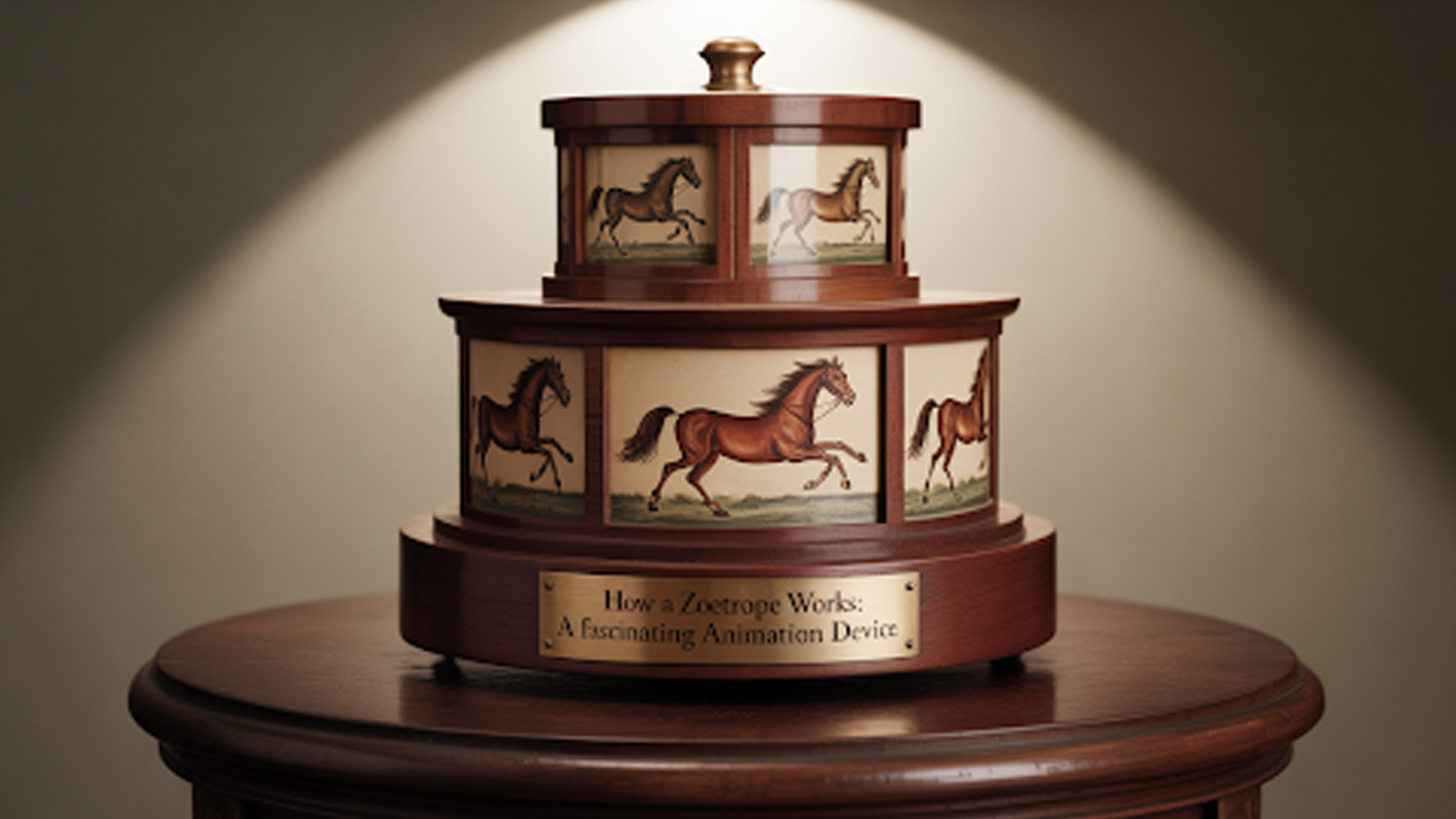When there was no direct concept of video in old times, devices like the zoetrope introduced animation with the help of spinning images. This device covered the gaps between static photos and moving visuals. The core principle of this device becomes the foundation of modern 2D and 3D animation.
Animatedvideos.co brings innovative motion graphics solutions that push the boundaries of animation. In this blog, we will break down the mechanics of the zoetrope and show how it laid the foundation for today’s animation technologies.
What is a Zoetrope?
A zoetrope is a mechanical device that creates the illusion of motion. It consists of a cylindrical drum with vertical slits on the sides. Inside, a sequence of images is arranged in a circular pattern. As the drum spins, the viewer looks through the slits, and the images appear to move.
The zoetrope was one of the first devices that gave the impression of motion through continuously moving pictures. It uses the persistence of vision phenomenon, which involves the human eye’s capability for memorizing images as continuous motion when spun quickly
How Does a Zoetrope Work?
Understanding the mechanics behind the zoetrope helps us appreciate its importance in animation history. A zoetrope has a simple but effective design. Here’s a breakdown of how it works:
- Structure of the Zoetrope
The zoetrope has a cylindrical shape. It contains multiple still images attached around the inner perimeter. The drum rotates, and the viewer looks through the vertical slits. These slits allow the eye to focus on each image at a specific interval. - Creating Motion from Still Images
The still images show a sequence of actions, like a person running or an animal moving. As the zoetrope spins, the human eye perceives a continuous movement due to the rapid transitions between the images. - The Role of the Slits
The slits play a vital role. They ensure that the viewer only sees one image at a time. This prevents the images from blurring into each other, which could disrupt the illusion of motion. - Persistence of Vision
Zeotrope works on the phenomenon of persistence of vision. It involves the human capability of storing an image in vision for a few seconds after the image disappears. Which is why the spin of images makes it feel like a continuous motion to the human eye
The History and Evolution of the Zoetrope
The phenakistoscope was invented in 1833 by Simon Stampfer and Joseph Plateau. It is regarded as the first widely used animation tool. Stampfer suggested using cylinders and looped paper strips for animation.
In 1834, William Horner created the zoetrope, calling it “daedalum” after the Greek myth of Daedalus. Unlike later versions, Horner’s zoetrope had slits between images, instead of above them. The word zoetrope meaning is “wheel of life,” was copyrighted in 1867.
Zoetropes became popular as Victorian parlor games. They led to the development of motion pictures and inspired later animation tools. In the late 20th century, the zoetrope was updated with 3D versions, including a Toy Story zoetrope by Pixar. Today, GIFs are seen as the modern version of the zoetrope.
How Zoetropes Impacted Animation
The zoetrope was one of the first animation devices to demonstrate how still images could create the illusion of movement. It influenced the development of later animation techniques such as flip books and film strips. Even modern Pixar animation owes some of its principles to these early devices.
Without the zoetrope, modern animation may have taken a different path. It was the first tool to teach animators about timing, sequencing, and motion, paving the way for advanced techniques like rubber hose animation and motion graphics.
Applications of the Zoetrope in Modern Animation
Despite its historical connections to 19th-century amusements, the zoetrope has influenced animation even today. For many contemporary animators and artists, the zoetrope encourages a renewal of interest in hand-operated animation methods.
Zoetropes are currently installed in art installations, animation studios, and simply used to reflect upon the beauty behind the unpredictability of hand-made and analog techniques.
With many vintage animation tools reemerging into modern studios, it seems the zoetrope’s symbolism does not only pertain to the history of animation, but also provides a reference point for how much animation has evolved, yet so many of the foundational ideas remain relevant to today’s digital practices.
How to Make a Simple Zoetrope
Creating your own zoetrope is simple and fun. Here’s a basic guide:
Materials Needed:
- A cylindrical object (like a cardboard tube or a plastic bottle).
- Printed images (sequence of frames).
- Scissors.
- Tape or glue.
- A slit template (you can cut slits in the paper or cardboard).
Steps:
Step 1: Cut out the template strips along the dotted lines, and fold them. Cut out the designated triangles from both strips to make the viewing slit. Fold the pages together and secure them with tape loops.
Step 2: Tape all the sheets together to form a circle with the images. Avoid folding tape inside it. Then tape the circle edges with the CD edge. Make sure to create a flawless ad firm circle out of this.
Step 3: Put one washer firmly over the chopstick’s tapered end. Make sure the zoetrope strip is facing up before setting the CD in the washer. Then, sandwich the CD between the two washers by putting the second washer over the tapered end.
Step 4: Hold it with a small incline. Spin the CD and peer through the slits you created. The images throughout ought to be dynamic and provide the impression of movement. Spin the CD in the opposite direction if they’re going backward.
Why Zoetropes are Still Relevant in Animation
While the zoetrope is a historical animation device, it has had a lasting impact on the world of animation. The motion principles are still applicable today, particularly in motion graphics. Animators, whether they are aware or not, continue to look to historical forms of animation for inspiration when developing new work.
In modern animation, creating movement and telling a story visually are very important. Although the zoetrope may seem old-fashioned, it is still relevant today, especially for people who enjoy animation.
FAQs
What is meant by a zoetrope animation?
A zoetrope animation is a spinning cylinder. Inside are images arranged in sequence. When it spins, the pictures start blending together to make a motion.
How does the zoetrope create motion?
It uses persistence of vision. Your eyes blend one image with the next. The result feels like smooth movement.
Who invented the zoetrope?
William Horner designed it in 1834. He first called it the daedalum. Later, it became known as the zoetrope.
Why is the zoetrope important?
It showed pictures could become moving stories. This idea influenced film and animation. It built the path for modern techniques.
Is the zoetrope still relevant?
It is, indeed. Animation is still based on the zoetrope's fundamental idea of bringing still images to life, despite the fact that we now use sophisticated software and digital tools. When creating contemporary motion graphics that captivate and motivate, we at Animatedvideos.co frequently refer back to these classic methods.
How is it different from a flipbook?
Flipbooks need pages flipped quickly. Zoetropes use a spinning drum instead. Both show motion through sequential images.
Can I make a zoetrope at home?
Yes, it’s a simple craft project. Use cardboard, drawings, scissors, and tape. Spin it, and the pictures will move.
Where can I see zoetropes today?
They appear in galleries and museums. Some animation studios still showcase them. Modern 3D versions are also displayed.
What can animators learn from zoetropes?
They teach patience, timing, and storytelling. These lessons remain vital for animation. Animatedvideos.co combines them with digital creativity today.
Conclusion
Zeotrope is not just an old animation device but an important pillar of modern animation. From motion graphics to 3D animation, the foundation principle remains the same, which is provided by Zeotrope.
In order to ensure that every project adheres to the fundamentals of animation while utilising the newest technology, we at AnimatedVideos.co embrace both conventional and modern animation approaches. We provide innovative solutions that make your story come to life, whether you’re making explainer videos or a commercial videos.



